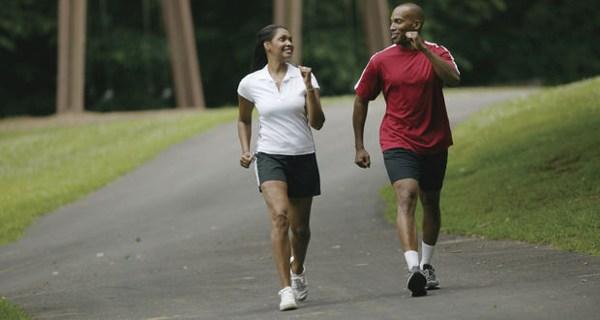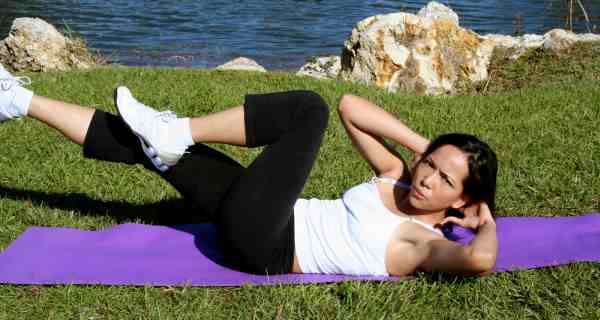The right way to walk and lose weight

Sitting down or being virtually inactive longer than four hours can slow down your metabolism and make your body store fat. If you have a job which demands you to sit for long hours, you specially tend to put on weight around your stomach and hip. To avoid this, walking becomes a must to boost your metabolism. While walking is primarily a cardio exercise, many of us resort to walking for weight loss as well. But hold your horses for a minute and think – is the way you walk really helping you lose anything except energy?
We attribute pain and injuries to the fact that we haven’t walked in a long time so it’ll obviously hurt a little but be cautious because the real reason may be that you are not striding the right way. Here are a few tips to take into account:
- Smaller steps: Subconsciously we start taking big steps which is almost like lunging ahead so that we can cover more distance but this is a bad idea because it causes a lot of strain on your feet and shins. Instead, take smaller steps – you can quicken your pace though. You can also keep a moderate pace and walk for half an hour to 60 minutes. Did you know walking a 100 steps after dinner also has many benefits for your health?
- Increase the distance: The more you walk, the more you stand a chance of a better workout. Increase your distance every day by half a kilometre – small enough to be easy. For those who have just begun walking, this will help build your leg muscles.
- Stretch: Before you commence your walk, remember to stretch amply in order to loosen up those muscles – and not just your legs but your entire body. This helps avoid the sore pain the next day. Stretching should also be done after a walk. Here are some stretching exercises that will help improve your flexibility.
- Watch your pace: How quick is quick, you might be wondering. To begin with, don’t stroll. Walk fast enough so that you can still talk but your breathing is harder than usual. Increase your pace as the week passes because you are stronger now.
- Limb movements: Don’t walk like a robot – let your shoulders move naturally and swing your arms in a natural motion; don’t try to keep them tight by your side. Keep your elbows close to your body. Don’t look down when you walk – keep your chin parallel to the ground.
- Take a break: Don’t push yourself up to walking every single day – your body needs rest so take a break once in a week. If you have to exercise, opt for upper body workouts.
- Watch what you eat: If you are going to exercise, you need to keep an eye on your food intake as well, specifically calories. For women, 1200 calories and for men or active women 1500-1600 calories is the upper limit.
- Track your progress: Get yourself some digital assistance to progress how well you are really doing. A pedometer can help you track your distances and time so that you know how far you’ve walked on any given day.
- Mix it up: If you want some variety in your walking schedule, revise your workout a little. One day you can walk slow but longer distance, the next you can walk fast for a shorter distance. This helps stave off boredom too.
- Go easy on the post-walk eating: Of course you’ve walked a long way and obviously you are hungry – you could probably eat for two tonight – don’t. For the first few days it’ll be difficult ignoring the hunger pangs you get after you’ve begun walking regularly but instead of heavy dinner (if you are an evening walker, that is), have a fruit instead or a salad.
Here are answers to some frequently asked questions about walking the right way:
- Do I need special shoes?
No, because walking doesn’t need shock absorbents like running shoes do. But if you have had any past foot or knee injuries it’s best to consult your doctor in case you need some special support on your ankle. Apart from that all you need to see is that the shoe fits snugly and not tight or loose. Try walking in them and judge whether they are right for you. Needless to say, flip flops or open sandals aren’t the right footwear. Here is you can choose the right workout clothes.
- Can I jog in intervals instead of walking continuously?
Yes. Warm up with a short walk and break into a slow jog or a run, whichever you like. If you walk for 15 minutes, you can run for 5 mins. However, once you are done jogging, start walking immediately to avoid your legs from tiring. If you take a break, it becomes difficult to run the next time.
- I listen to music while walking – is that ok?
Why not? Find yourself some peppy numbers and be on your way. It’s a great way from keeping walks dull and is a good motivating tool. Very important, however, that you make sure you pay attention to passersby and vehicles. Here are 10 must have walking songs for your playlist.
- Company is good, right?
Not always. While it’s good moral support to have someone along with you, you also need to make sure you don’t dawdle or that your brisk walk turns into a stroll while you gossip. Also don’t be so dependent on your companion that if they can’t walk, you have a ready excuse not to.
- Does walking on tar roads harm my knees?
A lot of experts have said that running on tarred roads does, at least over an extended period of time. This is because of the hardness of the surface the shock of which the knee can’t tolerate. It’s better to be cautious even if you are just walking, especially if you are older. Find a park or any non-tar surface to walk on. If you can find yourself a beach – great! Having a treadmill at home is also a good option but nothing beats the fresh air of outdoors.
- What if I have had a knee operation or any other kind of lower limb surgery/injury?
This cannot be stressed enough: if you have had any kind of injury, however minimal, please don’t push yourself into a walking regimen without consulting a doctor. For all you know, you’ll make it worse. Even if you’ve had a surgery, get a doctor’s opinion (and a second opinion) to make sure you are fit enough to walk. And of course, try to find a soft surface to walk on. Here are 7 tips to relieve knee pain.
Walking is a great exercise option – no fuss no muss and you can go whenever you want, there’s no equipment or special workout dress code you need to follow – but walking the right way is just as important if you are looking for a weight loss option. Stick by these tips and you’ll see the difference for yourself!
For more articles on weight loss, visit our weight loss section. For daily free health tips, sign up for our newsletter.
-
Revealed — betel leaf home remedy for weight loss
-
Is cardio alone enough for weight loss? (Fitness query of the day)
-
Is walking, jogging or running outside better than the treadmill for weight loss?
-
Try ardha shalabhasana to lose fat from your hips and butt
Word
-
WhatIs a Height and Weight Chart?
Height and weight charts can determine whether you’re the correctweigh
-
Can I get ripped in 12 weeks?
- DON'T MISS
- 10 diet habits that guarantee weight loss
- Weight training or cardio – which one should I do first?
- Very low-caloriediets
- 5 habits that are making you fat!
- How to Choose a Diet
- Calcium Rich Recipes: Bajra aur kaddu ki roti
- Revealed — 12 shocking reasons why you are gaining weight!
- Stop doing these 6 things to reach your weight loss goals
- How to lose weight at home – exercises, yoga and diet tips
- Fitness Plan Day #173– Walk 10,000 steps daily to lose weight




